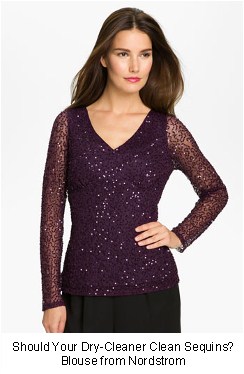Can you trust your dry-cleaner with your most treasured garments, like your wedding gown, quincinera dress, or expensive blouses with beads and sequins?There are many dry-cleaners that you may want to avoid. But, wait, aren’t all dry-cleaners the same? Not at all. Not only do they differ in experience, but they also use different cleaning solvents.
Because of environmental and medical impact, dry cleaning shops are regulated by state environmental agencies. And as America becomes more and more concerned with air quality and health, some dry cleaning solvents are even being outlawed in some states. Consequently new solvents are emerging to replace traditional ones that are safer for the environment and for our health. So which solvent does your dry cleaner use and what is it good for or not good for?
 Chances are your dry cleaner uses one of these solvents:
Chances are your dry cleaner uses one of these solvents:
- Perchloroethylene
Commonly called perc. this is the still the most common solvent that dry-cleaners use. It is the best solvent for degreasing and may be your best choice if for greasy stains on silk, rayon, or acetate fabrics. However, this solvent is more likely to damage sequins and beads on wedding gowns, or melt the glue if they are glued on. - Stoddard solvent.
Harder to find, this is an older petroleum-based solvent that is becoming rare. Because of fire regulations, this solvent cannot be used in strip mall type dry-cleaning establishments, and is therefore not commonly used. You may find this solvent in older dry-cleaning shops that have been around for a while. It is safer for cleaning dresses with sequins and beads than perchloroethylene. The Stoddard solvent shouldn’t melt beads and sequins or affect the glue if they are glued on. - Hydro-carbon (Also called DF2000)
This is a more recently formulated petroleum-based solvent. Like the Stoddard solvent, it is safer for beads and sequins, but is not quite as effective at degreasing as perchloroethylene and the Stoddard solvent. However, it has fewer fire restrictions than the Stoddard formula and is becoming quite popular as many dry-cleaning shops change over to this new solvent. - Siloxane (Greenearth)
This is a fairly new silicone based solvent. Like Hydro-carbon, it is safer for beads and sequins, but is not quite as effective at degreasing as perchloroethylene and the Stoddard solvent. However, it is safer for the environment and has less government restrictions than any other solvent. - Water
Yes, it is true that a number of dry cleaners have switched over to wet cleaning. With their new high tech machines they insist that they can clean any garment with water. It does have the advantage of cleaning water based substances, which dry-cleaning solvents do not do..
So which does your cleaner use and why would it matter? For general cleaning, it may not matter much, however if you are cleaning an expensive garment with beads and sequins (like most wedding gowns), avoiding perc. may be a good idea. However perc is fabulous for dirty hemlines, which are very common with wedding gowns. So, if your gown does not have beads and sequins, it should be safe.
If your cleaner is now strictly wet cleaning, ask to see some of the wool suits they have cleaned or silk dresses before you leave your costly garments with them. You may be pleasantly surprised at the results.
If you are concerned with the environment above all other considerations, Greenearth dry cleaning and/or wet cleaning are your most earth friendly choices.
